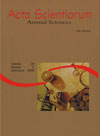<b>The influence of two diets on the quality of water in nursery tanks used in marine shrimp (<em>Litopenaeus vannamei</em>, Boone, 1931)</b> - DOI: 10.4025/actascianimsci.v28i1.670
Abstract
Experiments were carried out in a commercial marine shrimp farm in order to evaluate the use of two diets in Litopenaeus vannamei post-larvae, during nursery phase, on physiochemical wastewater quality. Two feeding methods were adopted: Commercial Feeding Method (MAC) and Artemia Feeding Method (MAA).0 The nursery tanks (60 m3) were provided with 19 days post-larvae (PL19) with a stocking density of 16PL/liter. After 10 days of culture, the concentrations of nitrogen (ammonia, nitrite and nitrate) and phosphorus compounds (total phosphorus and orthophosphate) in the nursery tank were smaller for MAC, rather than MAA treatment (p < 0.05). Consequently, MAA treatment induced low levels of daily compounds increment, thus contributing to a significant reduction of the nutrients that caused water eutrophication.Downloads
Download data is not yet available.
Published
2008-02-15
How to Cite
Silva, A. P. da, & Mendes, P. de P. (2008). <b>The influence of two diets on the quality of water in nursery tanks used in marine shrimp (<em>Litopenaeus vannamei</em>, Boone, 1931)</b> - DOI: 10.4025/actascianimsci.v28i1.670. Acta Scientiarum. Animal Sciences, 28(1), 105-111. https://doi.org/10.4025/actascianimsci.v28i1.670
Issue
Section
Animal Production
DECLARATION OF ORIGINALITY AND COPYRIGHTS
- I Declare that current article is original and has not been submitted for publication, in part or in whole, to any other national or international journal.
The copyrights belong exclusively to the authors. Published content is licensed under Creative Commons Attribution 4.0 (CC BY 4.0) guidelines, which allows sharing (copy and distribution of the material in any medium or format) and adaptation (remix, transform, and build upon the material) for any purpose, even commercially, under the terms of attribution.
Read this link for further information on how to use CC BY 4.0 properly.
0.9
2019CiteScore
29th percentile
Powered by 








































